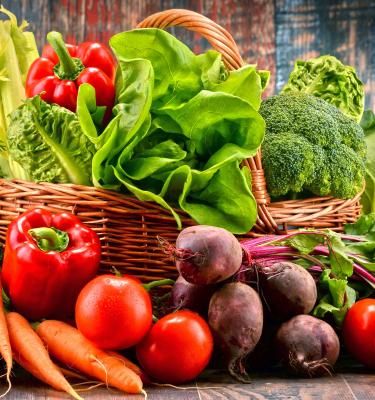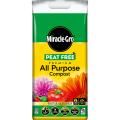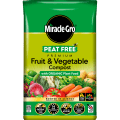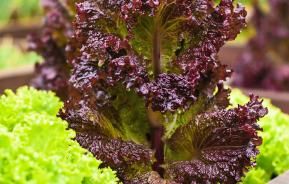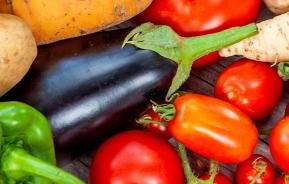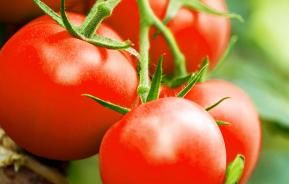If you’re new to growing your own food, the first question that springs to mind is ‘What vegetables can I plant now?” The good news is that although spring is the most important planting season for vegetables, it’s possible to sow or plant vegetables practically all year round provided you choose the right varieties.
Whether you’re planting in a vegetable bed, in pots on a patio or in an allotment, a vegetable sowing calendar helps you to keep track of what to sow when for the best harvests. Our planting calendar lets you know when to start sowing seeds indoors in spring, what to sow in summer and when to sow seeds in autumn for early crops the following spring.
When to plant vegetables
There’s no simple answer to the question of “when is the best time to plant vegetables in the UK”, so the best solution is to check the information on seed packets before you sow. Here are a few examples of how the UK planting season for various vegetables can differ:
- Tomatoes, aubergines and chilli peppers need plenty of sunshine and warmth in order for their fruit to ripen, so to make the most of the changeable UK weather, they need to have reached a suitable stage of growth by the time summer arrives. This means they must be sown indoors in early spring and grown inside until the weather outside is warm enough for them to be planted out
- Quick-growing crops like cress, rocket and salad leaves can be sown throughout the year. In summer they can be grown in between other slower-growing crops, maximising the use of the planting area, as well as adding colour and aesthetic appeal. In winter they can be grown on a sunny windowsill and harvested as micro-greens, with new plants being sown every 2-3 weeks for a constant supply throughout winter.
- Brassicas like cauliflower and broccoli are slow-growing and take several months between sowing and harvesting, so they are usually sown indoors or in seed beds in early spring, and transplanted to their final location when they are large enough. This allows the beds to be used for other, faster-growing crops like beetroot or radishes before the brassicas are planted out. Brassicas can also be sown indoors in winter and planted out in spring for early harvests.
When to plant potatoes

When to plant potatoes depends on whether you are planting first earlies, second earlies or maincrop potatoes. First and second early potatoes are the delicious waxy ‘new potatoes’ that start appearing on supermarket shelves from early summer. These are planted in late March and harvested in June and July. Second early potatoes are planted in early to mid-April and harvested in July and August. Maincrop potatoes, which are larger and take longer to mature, are planted in mid to late April and harvested from late August to October.
When to plant tomatoes
Tomatoes need a long period of warm weather in summer for the fruit to develop and ripen, so they need to be started off early in spring. However, it’s best not to start them off too soon, as the seedlings will grow leggy and spindly if the light levels are too low. If the plants are to be grown in greenhouses, sow tomato seeds indoors in a heated propagator or on a sunny windowsill in late February. Tomato plants that are to be grown outside can be sown indoors from late March to early April.
When to plant carrots
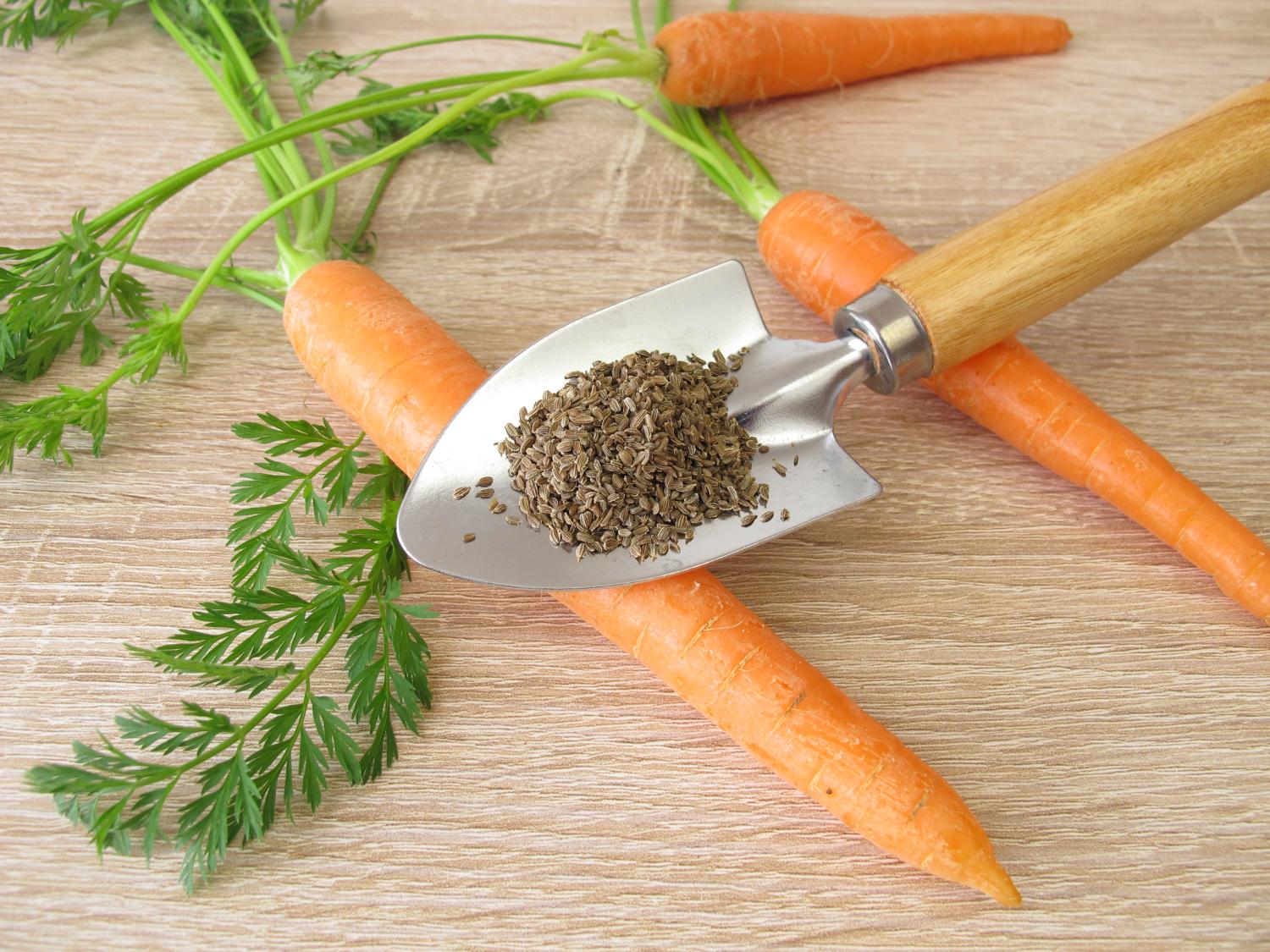
Carrots have long tap roots and don’t like to be disturbed, so they are best grown from seed sown directly into the beds that they will grow in. Early sowing carrots can be sown outdoors from February onward under cloches or fleece to protect them from frost, and maincrop carrots can be sown from April to July. Carrots are ready to harvest between 3-4 months after sowing. If you want continuous harvests throughout the summer, sow a new batch of carrot seed every 3-4 weeks.
When to plant onions
Onions are usually grown from sets (these are essentially just small onions), and these sets can be planted out either in autumn or in spring, depending on the variety you choose. They’re usually ready to harvest from mid-summer to early autumn, with autumn-sown varieties ripening earlier than spring-sown.
How to sow vegetables
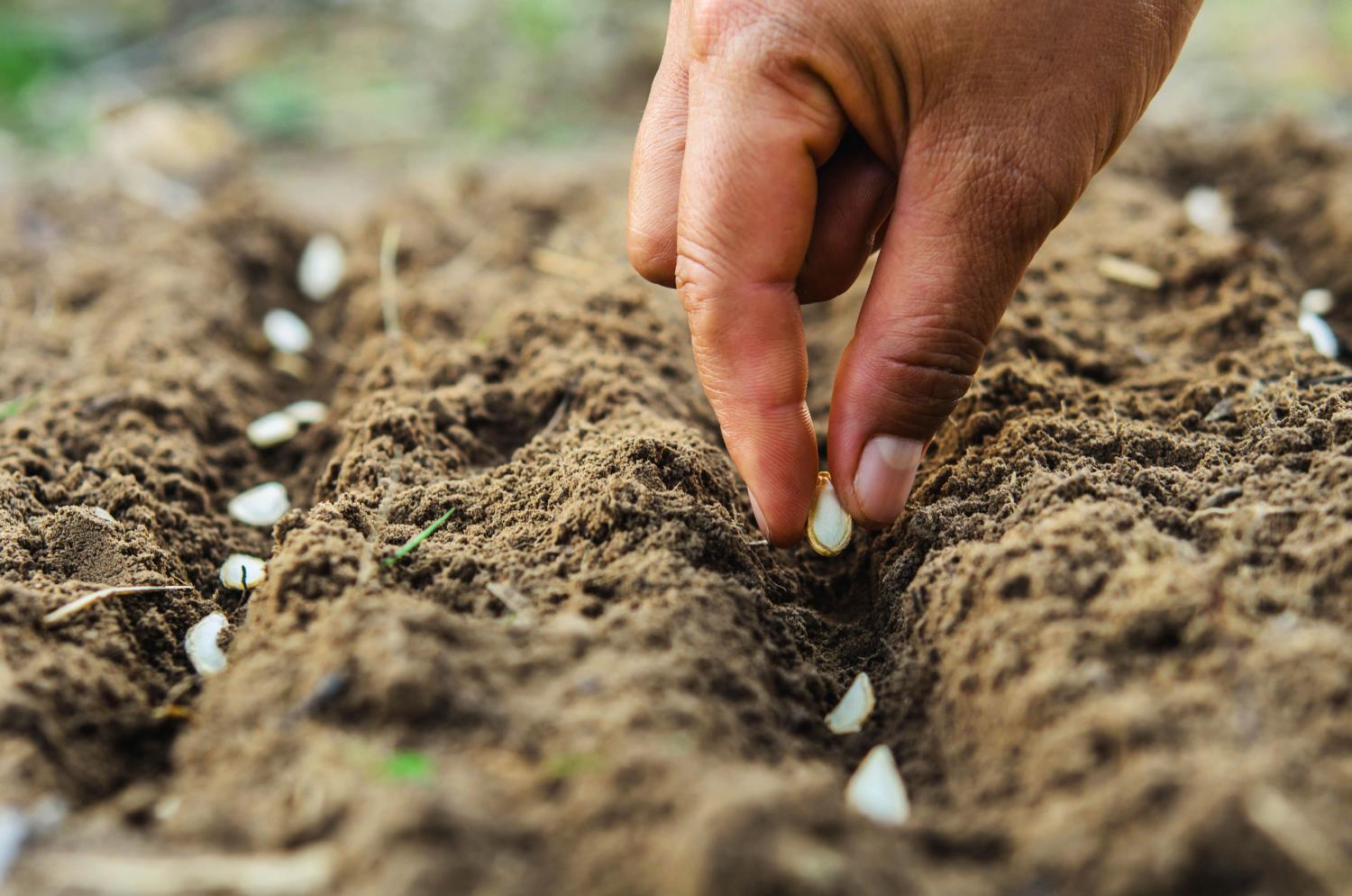
If you’re new to vegetable growing, you might feel overwhelmed by all the strange new terminology on seed packets, so here’s a guide to some of the most common terms and what they mean.
Direct sowing
Sowing seeds directly means sowing them into the beds they are to grow in, rather than in pots for planting out later.
Sowing indoors
Seeds are usually sown indoors to protect the seedlings from cold winter weather or from pests such as mice, slugs or snails. The seeds can be sown in modules, seed trays or individual pots filled with either multi-purpose compost or seed compost and placed in in a greenhouse or any other frost-free environment to germinate. Some seeds germinate better in a warm environment such as a heated propagator, but if you don’t have access to a propagator, a simple alternative is to sow the seeds in individual pots, water them and cover each pot with a clear plastic bag and place the pots on a sunny windowsill. Remove the plastic bags once the seeds have germinated. The seedlings can be planted out once they are big enough to handle and after the last frosts are over.
Pricking out and potting on
Seedlings sown in seed trays rather than modules need to be ‘pricked out’ before they can be potted on. This can be done using any suitable thin stick, for example a dibber or a pencil. Hold the seedling by a leaf, not by the stem, to avoid damaging it, and use the dibber to gently ease its roots out of the compost. The seedling can then be potted on (i.e. replanted) into an individual pot filled with compost, where it can continue to grow until it is ready to be planted out into a bed.
Hardening off
Seedlings grown in a protected environment indoors, such as a greenhouse or a windowsill, need time to adjust to outdoor conditions before they can be planted out. This process is called ‘hardening off’. To harden off seedlings, place them outdoors in their pots during the day and bring them back indoors at night. Repeat this for at least two weeks. After this, the seedlings can be planted out.
Seed sowing calendar
January
Icy winter weather and cold, wet soil outdoors means that vegetable seeds have to be sown indoors or in a heated greenhouse this month, but you can still harvest some tasty crops for hearty winter soups and stews!
| Indoor sowing | Aubergine, Cauliflower, Lettuce, Onion |
|---|---|
| Outdoor sowing | Broad bean |
| Harvesting | Artichoke (Jerusalem), Brussels Sprout, Cabbage, Carrot, Cauliflower, Chicory, Kale, Leek, Lettuce, Parsnip, Swede |
February
There’s a high risk of frosts this month, but in mild weather some early seeds can be sown outdoors, protected with fleece or under cloches. Inside your home or in a heated greenhouse, the seed sowing season is starting to get underway, ready for spring.
| Indoor sowing | Artichoke (Globe), Aubergine, Broad Bean, Broccoli, Brussels Sprout, Cabbage, Cauliflower, Cucumber, Kohl Rabi, Leek, Lettuce, Onion, Pepper, Tomato |
|---|---|
| Outdoor sowing | Broad Bean, Carrot, Parsnip, Pea, Radish |
| Harvesting | Broccoli, Brussels Sprout, Cabbage, Carrot, Cauliflower, Chicory, Kale, Leek, Lettuce, Parsnip, Swede |
March
As the days start to get longer, it’s time for the vegetable garden to step up a gear and there’s plenty to sow both indoors and outside.
| Indoor sowing | Artichoke (Globe), Asparagus, Aubergine, Broad Bean, Broccoli, Brussels Sprout, Cabbage, Cauliflower, Celeriac, Celery, Courgette, Cucumber, Kale, Kohl Rabi, Leek, Lettuce, Marrow, Onion, Pepper, Shallot, Squash, Sweetcorn, Tomato |
|---|---|
| Outdoor sowing | Artichoke (Globe), Broad Bean, Beetroot, Broccoli, Brussels Sprout, Cabbage, Carrot, Kale, Kohl Rabi, Leek, Lettuce, Parsnip, Pea, Radish, Rocket, Samphire, Shallot, Spinach, Spring Onion, Turnip |
| Harvesting | Broccoli, Cabbage, Carrot, Cauliflower, Kale, Leek, Lettuce, Spring Onion, Swede |
April
Take advantage of warmer temperatures and April showers and get your vegetable garden growing!
| Indoor sowing | Asparagus, Aubergine, Broad Bean, Broccoli, Brussel Sprout, Cabbage, Cauliflower, Celeriac, Celery, Climbing Bean, Courgette, Cucumber, Dwarf Bean, Kale, Kohl Rabi, Leek, Marrow, Onion, Pepper, Pumpkin, Runner Bean, Shallot, Squash, Sweetcorn, Tomato |
|---|---|
| Outdoor sowing | Artichoke (Globe), Broad Bean, Beetroot, Broccoli, Brussel Sprout, Cabbage, Carrot, Cauliflower, Chard, Chicory, Courgette, Kale, Kohl Rabi, Leek, Lettuce, Marrow, Parsnip, Pea, Radish, Rocket, Samphire, Shallot, Spinach, Spring Onion, Turnip |
| Harvesting | Broccoli, Carrot, Cauliflower, Lettuce, Radish, Spring Onion |
May
It’s late spring and the vegetable garden is bursting into growth! Make the most of your space by keeping careful track of where and when you plant.
| Indoor sowing | Climbing Bean, Broccoli, Cabbage, Cauliflower, Celery, Courgette, Cucumber, Dwarf Bean, Kale, Leek, Pumpkin, Runner Bean, Squash, Sweetcorn |
|---|---|
| Outdoor sowing | Beetroot, Broad Bean, Broccoli, Cabbage, Carrot, Cauliflower, Chard, Climbing Bean, Chicory, Courgette, Cucumber, Dwarf Bean, Kale, Kohl Rabi, Leek, Lettuce, Marrow, Pak Choi, Parsnip, Pea, Pumpkin, Radish, Rocket, Runner Bean, Samphire, Spinach, Spring Onion, Squash, Swede, Sweetcorn, Turnip |
| Harvesting | Asparagus, Cabbage, Carrot, Cauliflower, Garlic, Lettuce, Pea, Radish, Rocket, Samphire, Spinach, Spring Onion |
June
Long days and warm weather make June one of the busiest months in the garden, with plenty of seeds to sow and crops to harvest.
| Indoor sowing | Pumpkin |
|---|---|
| Outdoor sowing | Beetroot, Cabbage, Carrot, Cauliflower, Chard, Chinese Cabbage, Climbing Bean, Cucumber, Dwarf Bean, Kohl Rabi, Lettuce, Pak Choi, Pea, Pumpkin, Radish, Rocket, Runner Bean, Spinach, Spring Onion, Swede |
| Harvesting | Asparagus, Beetroot, Broccoli, Cabbage, Carrot, Cauliflower, Garlic, Lettuce, Pak Choi, Pea, Potato, Radish, Rocket, Samphire, Spinach, Spring Onion, Tomato, Turnip |
July
All your hard work in the garden is starting to pay off this month, with your vegetable garden keeping your larder well stocked with tasty produce.
| Outdoor sowing | Beetroot, Cabbage, Carrot, Chard, Chinese Cabbage, Climbing Bean, Dwarf Bean, Kohl Rabi, Lettuce, Pak Choi, Radish, Rocket, Runner Bean, Spinach, Spring Onion, Swede |
|---|---|
| Harvesting | Artichoke (Globe), Beetroot, Broccoli, Broad Bean, Cabbage, Carrot, Cauliflower, Chard, Climbing Bean, Courgette, Cucumber, Dwarf Bean, Garlic, Kohl Rabi, Leek, Lettuce, Marrow, Pak Choi, Pea, Pepper, Potato, Radish, Rocket, Runner Bean, Samphire, Spinach, Spring Onion, Squash, Tomato, Turnip |
August
As fruit and veg start to ripen in the warm summer sun, keep harvesting regularly to make the most of your vegetable garden.
| Outdoor sowing | Cabbage, Chinese Cabbage, Kale, Lettuce, Pak Choi, Radish, Rocket, Spinach, Spring Onion |
|---|---|
| Harvesting | Artichoke (Globe), Aubergine, Beetroot, Broccoli, Broad Bean, Brussels Sprout, Cabbage, Carrot, Cauliflower, Celeriac, Celery, Chard, Climbing Bean, Courgette, Cucumber, Dwarf Bean, Garlic, Kohl Rabi, Leek, Lettuce, Marrow, Onion, Pak Choi, Pea, Pepper, Potato, Pumpkin, Radish, Rocket, Runner Bean, Samphire, Shallot, Spinach, Spring Onion, Squash, Sweetcorn, Tomato, Turnip |
September
September is one of the most important months for harvesting, but there’s still time to sow a last crop of radishes before winter and get your spring onion seeds in for next year.
| Indoor sowing | Lettuce |
|---|---|
| Outdoor sowing | Radish, Spring Onion |
| Harvesting | Artichoke (Globe), Aubergine, Beetroot, Broad Bean, Broccoli, Brussels Sprout, Cabbage, Carrot, Cauliflower, Celeriac, Celery, Chard, Chinese Cabbage, Climbing Bean, Courgette, Cucumber, Dwarf Bean, Garlic, Kale, Kohl Rabi, Leek, Lettuce, Marrow, Onion, Pak Choi, Pea, Pepper, Potato, Pumpkin, Radish, Rocket, Runner Bean, Samphire, Shallot, Spinach, Spring Onion, Squash, Sweetcorn, Tomato, Turnip |
October
There’s still plenty to harvest in October, and it’s time to start sowing seeds for early harvests next spring.
| Indoor sowing | Lettuce |
|---|---|
| Outdoor sowing | Broad Bean, Pea |
| Harvesting | Artichoke (Globe), Artichoke (Jerusalem), Aubergine, Beetroot, Broccoli, Brussels Sprout, Cabbage, Carrot, Cauliflower, Celeriac, Celery, Chard, Chicory, Chinese Cabbage, Climbing Bean, Courgette, Cucumber, Dwarf Bean, Kale, Kohl Rabi, Leek, Lettuce, Marrow, Pak Choi, Parsnip, Pepper, Potato, Pumpkin, Radish, Rocket, Runner Bean, Samphire, Shallot, Spinach, Spring Onion, Squash, Swede, Tomato, Turnip |
November
The growing season draws to a close in November as the last of the harvest is gathered in.
| Indoor sowing | Lettuce, Onion |
|---|---|
| Outdoor sowing | Broad Bean, Pea |
| Harvesting | Artichoke (Jerusalem), Broccoli, Brussels Sprout, Cabbage, Carrot, Cauliflower, Celeriac, Celery, Chard, Chicory, Chinese Cabbage, Kale, Leek, Lettuce, Parsnip, Potato, Pumpkin, Samphire, Swede |
December
While it’s cold and bleak outside, start planning for next spring by sowing seeds indoors and preparing your greenhouse for another year of vegetable growing!
| Indoor sowing | Lettuce, Onion |
|---|---|
| Outdoor sowing | Broad Beans |
| Harvesting | Artichoke (Jerusalem), Brussels Sprout, Cabbage, Carrot, Cauliflower, Celeriac, Chicory, Kale, Leek, Lettuce, Parsnip, Potato, Swede |
Using crop rotation
Crop rotation is a tried and trusted way to get the best out of your soil. Essentially, it means not growing the same crop in the same soil two years running. This means that pests and diseases like allium leaf miner or club root that attack specific crops don’t have a chance to build up in the soil, as the crops they affect simply aren’t there the following year.
Crop rotation also helps keep the nutrient balance in the soil correct. Different plants take different amounts of nutrients from the soil as they grow – for example, potatoes need a lot of nitrogen for healthy growth, whereas root vegetables like carrots need a soil low in nitrogen to stop them forking. Growing carrots in soil that was used for potatoes the previous year gives both crops the soil conditions they need. Most crop rotation plans work on a three- or four-year cycle. Here’s an example of a typical four-year crop rotation plan:
| Plot | Year 1 | Year 2 | Year 3 | Year 4 |
|---|---|---|---|---|
| Plot 1 | Potatoes | Onions and root vegetables | Legumes | Brassicas, followed by manure |
| Plot 2 | Onions and root vegetables | Legumes | Brassicas, followed by manure | Potatoes |
| Plot 3 | Legumes | Brassicas, followed by manure | Potatoes | Onions and root vegetables |
| Plot 4 | Brassicas, followed by manure | Potatoes | Onions and root vegetables | Legumes |
Companion planting
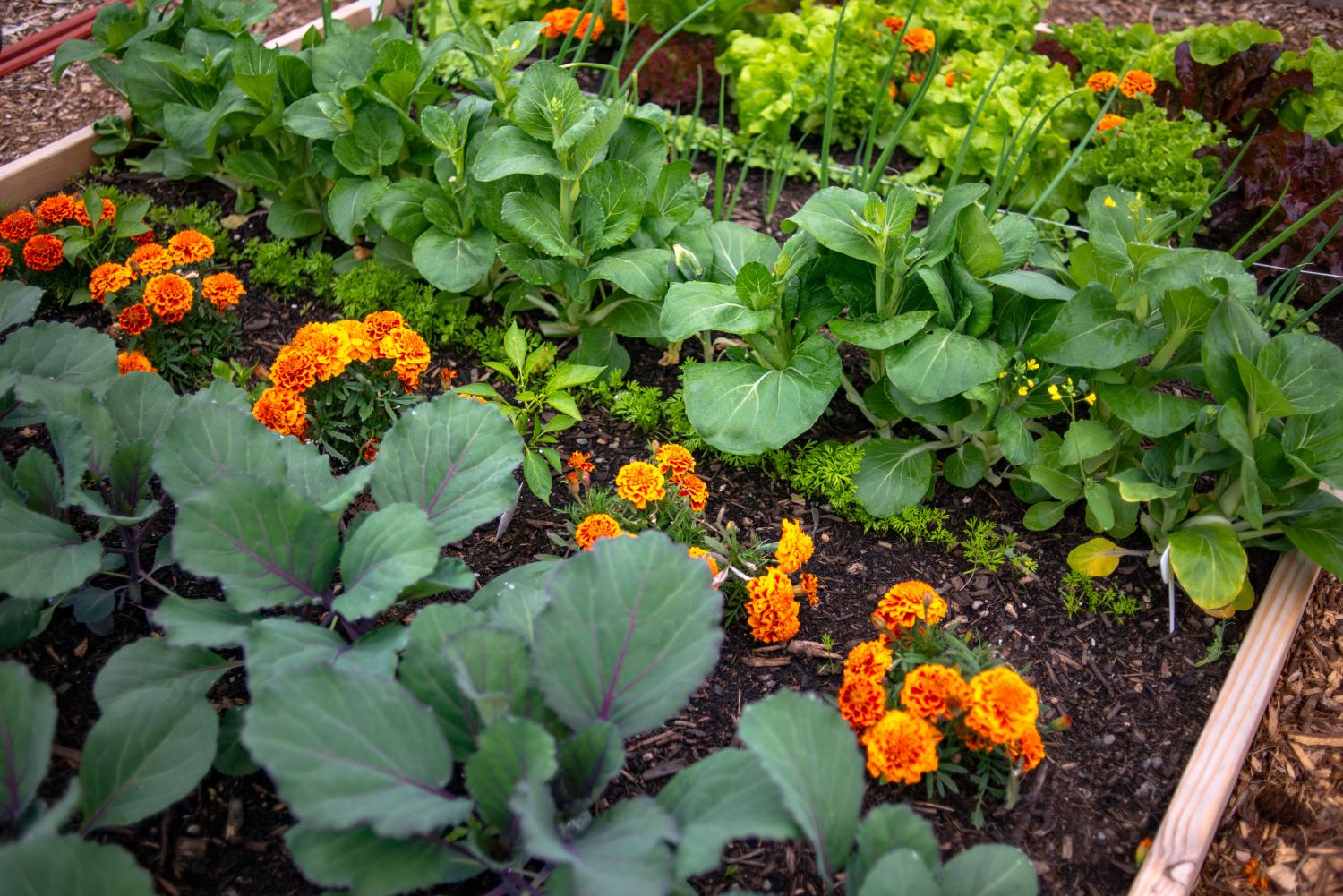
In the fight against pests and diseases, many plants can help each other. Companion planting involves planting specific plants together so that one or both plants benefit. Often, the scent of one plant can deter pests from attacking another - for example, spring onions can help protect carrots from carrot fly by masking their scent, and French marigolds are often planted together with tomatoes because the scent of the marigolds deters whitefly. Basil also does a good job of repelling aphids from greenhouse tomatoes, and it’s also said to improve the flavour of the tomatoes!
Companion plants can also be used to attract pests away from a crop. Nasturtiums can be used as a sacrificial crop to attract cabbage white butterflies away from brassicas – the butterflies lay their eggs on the nasturtiums instead, while the cabbages stay healthy and caterpillar-free. Marigolds attract slugs, which can then be removed and disposed of.
Pollinator-friendly flowers like yarrow, achillea and calendulas are ideal companion plants for a vegetable garden. As well as adding colour, they attract bees to pollinate your crops and hoverflies and ladybirds which help to keep down aphids. Try your own experiments with companion planting and see what works for your garden!
